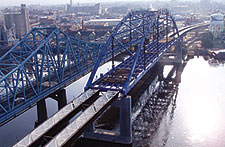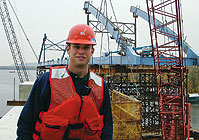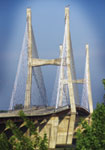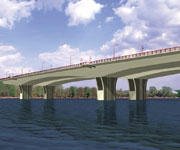...Dept. of Transportation and Development this month was scheduled to present an argument for design-building the bridge to state legislators, says Tony Ducote, bridge engineer administrator.
|
Economic Boost
The Highway 10 bridge would spur economic development in a depressed, agricultural area dotted with magnificent plantation homes. The project is funded by the Transportation Infrastructure Model for Economic Development program funded through a 4¢ fuel tax, says Paul Fossier, LDOTD project manager.
Anticipating the bridge, local cities began planning an 210-mile east-west parkway in 1992, between I-49 and I-59. "The bridge is a key to Zachary Taylor Parkway becoming a reality," says Billy DAquilla, mayor of St. Francisville.
The total 14-mile project length includes a four-lane, cable-stayed bridge with a 1,400-ft main span and two-lane approaches. The state has completed preliminary plans for a steel superstructure and concrete deck. If the project receives approval for design-build, DOTD will spend the next six to eight months on procurement documents with a planned 2005 bid, Fossier says. Ducote says design-build could lead to use of new technology: "There may be potential for something other than caissons."
The special fuel tax also funds the planned expansion of the Huey P. Long Bridge, a combined rail-highway steel trestle. Ray Mumphrey, DOTD project manager, says plans are complete for the substructure, which includes widening of the main piers. Environmental studies will be complete by March 2005.
Harrisburg-based Modjeski & Masters Chairman William B. Conway told engineers at a recent conference that widening poses "a pioneering engineering problem of the first magnitude." M&M is handling design for the $316-million job.
The 3,524-ft-long bridge is constructed on six caisson-supported and three pile-supported piers. It has two tracks with a bracketed roadway on each side that will be doubled to include three, 11-ft lanes in each direction plus an 8-ft shoulder.
"We are widening those piers on the existing caissons and we are fortunate that they could accept those loads," notes Mumphrey. The piers will be widened using steel brackets eventually concealed behind concrete panels. The steel trusses will be extended on either side with methodical balancing. "We [do not] know of another bridge in the United States that has been widened this way with this technique," Conway said.
The method will allow traffic to continue during construction but lengthens construction time. "The contractor and steel erector have to follow a fairly rigorous sequence of construction," he says.
 |
| OLD AND NEW. New arched truss crossing in La Crosse stands alongside old one to take on traffic. (Photo courtesy of Wisconsin DOT) |
Northern Crossings
Escalating traffic also spurred the need to expand a 2,573-ft-long cantilevered bridge in La Crosse, Wis. The 23-month, $40-million project adds two new lanes of U.S.-14/61-State Route 16, located 35 ft south of the two-lane Cass Street Bridge to take eastbound traffic in November. The existing bridge handles 19,000 vehicles daily with 28,000 expected by 2024. Steve Flottmeyer, project manager for Wisconsin Dept. of Transportation, says rehabilitation of the old bridge will begin early next year. Lunda Construction Co., Black River Falls, Wis., completed its $22.5-million contract in June for two 60-ft-deep pier footings, a massive arch truss main span and 11 piers. Approach work, concrete deck placement, lighting and other aesthetics are nearing completion.
The La Crosse job hit a critical milestone when the 475-ft-long main span floated into place last December (ENR 12/22/03 p. 16). Lunda installed the 2.8-million-lb arch truss in eight hours after a massive coordination effort that took nearly nine months to plan.
 |
| YOUTHFUL TALENT. Frederick handled truss float-in at age 28. (Photo courtesy of Lunda Construction Co.) |
"It was a huge exercise in logistics," says Brady J. Frederick, project manager. A U.S. Navy Civil Engineer Corps veteran and only 29 years old, he drafted plans for a 40-member team and provided to-the-minute agendas. "He did a very fine job for us," says Lunda project manager Paul Nortman. Frederick coordinated with the Corps of Engineers to adjust channel water levels, among other tasks.
The channel had to remain open for freight traffic, so Lunda opted to erect the span downstream on 68 ft of falsework anchored to three barges. After the float-in, crews pumped water into the bulkheads. Workers made one bearing adjustment of less then a quarter inch to finish installation.
 |  |
The project was marred by the 2003 death of 34-year-old Anthony J. Poterala, an ironworker. For reasons still unknown, he apparently unclipped his lanyard, tightroped across the truss and fell 65 ft onto a crane barge. The Occupational Safety and Health Administration proposed $2,500 in fines. The inspection is still open and civil litigation is pending.
Lunda also holds a $120-million contract with Minnesota Dept. of Transportation to construct two new segmental bridges over the Mississippi carrying I-494 traffic in St. Paul. Named "Wakota"an amalgam of Washington and Dakota countiesthe $250-million job is scheduled to finish in 2007.
 |
| PAST AND FUTURE. Cape Girardeaus recently opened Bill Emerson Bridge (above left) would be followed by other major new Mississippi River bridges, including the Wakota Bridge (above right) and a $1-billion new St. Louis crossing (below). (Photos Courtesy of HNTB) |
Awaiting federal and state funding is the biggest Mississippi crossing of all, designed to carry I-70 traffic between St. Louis and Illinois. The 10-year project would include the widest cable-stayed bridge in the world, at 222 ft. When finished, the $1.6-billion M&M-designed bridge would span 2,000 ft over the river, with a total three-span length of 3,150 ft.
Illinois and Missouri have been planning the new crossing since 1992. The project is aimed at reducing I-55/64/70 congestion on the existing bridge. "Im hoping that there is execution soon but it is all contingent on the federal transportation bill," says Mary Lamie, Illinois DOT District 8 engineer.

Post a comment to this article
Report Abusive Comment